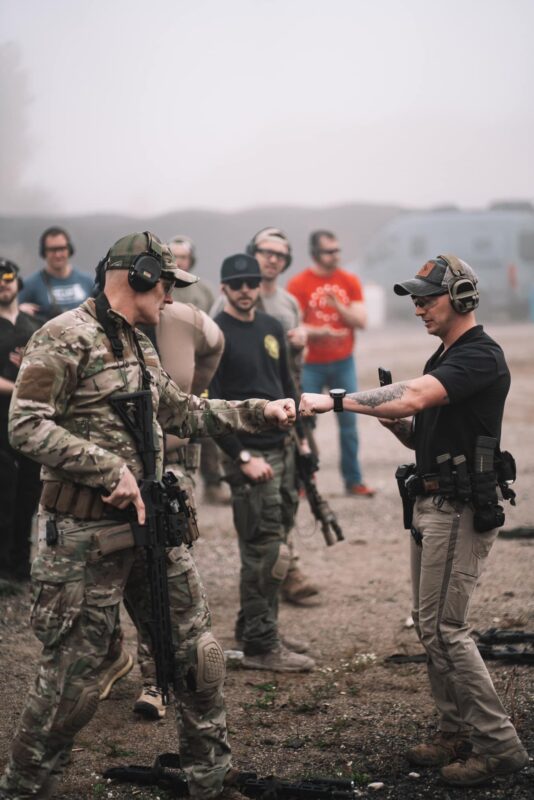HOP Blog
The Achilles Heel Tactical Man Card Drill
The “Man Card” Drill is a demanding and performance-driven exercise designed to test a shooter’s proficiency with both rifle and pistol.
Developed almost six years ago by Rick Crawley over at Achilles Heel Tactical, this drill aims to challenge shooters—particularly law enforcement officers—by pushing them to perform under controlled stress.
The idea is to make every shot count, from the first to the last, under various conditions and with strict time constraints.
Origins of the Man Card Drill
The Man Card Drill was conceived as a solution to a problem: how to maintain high training standards when ammunition became scarce. With budget cuts affecting ammo allotments, the need arose for a performance-based test that used minimal ammunition yet provided meaningful results. The drill’s design not only emphasizes accuracy but also incorporates stress, aiming to simulate real-world pressure in a controlled environment. The goal is to ensure that every shot is accountable and that the shooter remains composed and effective throughout the exercise.
The Drill’s Structure
The Man Card Drill, often referred to as the “short card,” consists of five iterations. These are designed to test different aspects of a shooter’s skills, including readiness, speed, and the ability to transition between weapons. Here’s how the drill is structured:
- Compressed Ready Pistol Shot: The shooter starts from a compressed ready position and must fire one shot within one second.
- Holster Draw Pistol Shot: The shooter draws from a holster and fires one shot. This must be accomplished in 1.5 seconds, regardless of the level of concealment or retention.
- Low Ready Rifle Shot: From a low ready position, the shooter snaps the rifle up to the target and fires one shot within one second. The rifle is held at a 45-degree downward angle, ensuring a standardized starting point.
- High Ready Rifle Shot: The shooter starts with the rifle in a high ready position, looking over the muzzle, and fires one shot within one second.
- Rifle to Pistol Transition: The shooter begins in any ready position, performs a tactical reload with an empty rifle magazine, and transitions to the pistol, firing one shot. This must be done in 2.5 seconds.
Each of these steps emphasizes the need for both speed and accuracy. The shooter gets two attempts per iteration, but all shots must hit the target’s C-zone—a designated area on a C-zone steel target or IPSC C-zone—to count as a pass.
The Significance of the Man Card
Completing the Man Card Drill earns the shooter a “Man Card,” symbolizing their ability to perform under pressure. Only 65 Man Cards have been awarded in the past four years, making it a rare and coveted achievement. Some individuals have managed to earn multiple Man Cards, with one individual holding seven cards, a testament to their consistent proficiency.

The Man Card is not just a physical card but a representation of the shooter’s skill and composure. It also serves as an admission ticket to attempt the “long card,” a more challenging version of the drill that involves completing 14 iterations under even stricter conditions. The long card is designed to push the baseline established by the short card, further testing the shooter’s performance on demand.
The Role of Stress in Training
A critical element of the Man Card Drill is the controlled stress environment it creates. By performing in front of peers and under the watchful eyes of an instructor, shooters experience a level of pressure that reveals their strengths and weaknesses. This stress helps shooters understand how they might react in real-life situations, such as a shooting or gunfight, although the stress in the drill is far less intense than in actual combat.
The goal is to make shooters aware of their limitations so they can address them in their training. This awareness and improvement lead to a higher level of preparedness and responsibility, especially for law enforcement officers and armed civilians who may need to use their weapons defensively.
The Importance of Instructor Performance
One of the key points emphasized during the drill is the role of the instructor. An instructor should not only be able to teach the drill but also demonstrate it. This means they should be willing to perform the drill in front of the class, regardless of the outcome. By doing so, instructors instill confidence in their students and show that the standards they set are achievable and grounded in real-world effectiveness.
RELATED – DOPE Drill: Mastering Speed and Accuracy on the Range
Conclusion
The Achilles Heel Tactical Man Card Drill is more than just a test; it’s a benchmark for shooters who take their training seriously. It challenges individuals to step out of their comfort zones, confront their limitations, and strive for excellence under pressure.
Whether you’re a law enforcement officer or a responsible armed citizen, the Man Card Drill provides a valuable opportunity to assess and enhance your skills. By participating in this drill, shooters not only prove their ability to perform on demand but also contribute to a culture of accountability and excellence in the tactical community.

